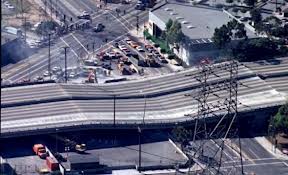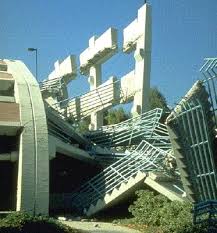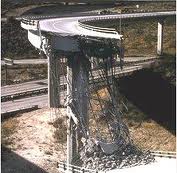It was Twenty Years Ago Today….
Twenty years ago today, January 17, was an event I shall never forget: the Northridge earthquake of 1994. Born and raised in Southern California, I’ve lived through the 1971 Sylmar quake, the 1987 Whittier quake, and many, many smaller events that most people have forgotten. The events were traumatic to anyone who experienced it, even at great distances, and for years afterwards I could remind my students about how it felt, and how it changed Los Angeles. Unfortunately, time marches on, and now that it is 20 years ago, most of my college students either were too young to remember, or were not even born yet!
It struck at 4:31 in the morning, in total pre-dawn darkness, on a Monday that was the Martin Luther King holiday. Luckily, it meant that most people were sleeping and fewer than usual were headed to work, so the casualties were much less than if it had hit during the peak of rush hour. Even though it had a moment magnitude (Mw) of “only” 6.7, its upward acceleration of the ground motion was 1.8 g, much stronger than many quakes of the same size, and the highest ever recorded in an urban area in North America. It seemed to last a long time, although it actually lasted only 10-20 seconds. There was another Mw = 6.0 aftershock an hour later, and another 11 hours later. It was felt strongly as far as Las Vegas, an unusually long distance for southern California quakes (which tend not to propagate very far because of the shattered, highly faulted blocks in our crustal rocks don’t transfer energy well). Contrary to the name, its epicenter was not Northridge, but in Reseda, a town to the south—and both were very close to where I now teach at Pierce College in Woodland Hills. The initial reports of the magnitude as 6.6 and the epicenter at Northridge proved to be wrong once better seismic data came in a day later.
I remember it vividly as if it were just yesterday. My family and I were sound asleep in our house in Sunland, California, when it shook the house strongly and then stopped. Since we were built on a bedrock ridge, the vibration was short and not very damaging. Just a few items fell off the walls and shelves, and some large mirrors leaning against the bedroom walls fell over. In the total darkness with no glasses on, I fumbled across our waterbed to the bed of my (then) 2-year-old son, which was covered with large shards of glass from a mirror that had toppled right over him. I grabbed him and dragged him to our bed, and luckily no one was cut. Once the aftershocks were over, we found flashlights and candles, and did what we could to assess damage and pick up the broken glass. My son, however, would not settle down and go back to sleep, and insisted on seeing his Sesame Street videos to comfort himself–but we didn’t get power restored for many hours. Eventually, we all fell asleep again, and awoke at dawn when we could walk around and see the damage better. Thanks to being on a bedrock ridge, the damage was very minimal, except for the broken glass mirrors. No signs of gas leaks, no cracks in our chimney or house or foundation, nothing that would be a problem. Nevertheless, all we could do was sit tight and wait for power to be restored, and avoid going out on the road that day. We got what info we could from our battery-powered radio, then when power and TV came on, we saw what had happened elsewhere.
The worst damage was in the western San Fernando Valley near the epicenter, where a number of buildings had collapsed (particularly those with underground parking structures beneath heavy construction). A lot of chimneys fell, and a few concrete walls that had no steel rebar reinforcement, but nowhere near as many as you’d expect, since all masonry structures in California must be reinforced by steel rebar through them (ever since the 1933 Long Beach quake changed the state building codes). The loss of life is estimated between 60-70, depending on what you count as earthquake-related deaths. A high ramp at the Interstate 5-Hwy. 14 interchange fell (just as it had done during the 1971 quake), and a California Highway Patrol motorcycle officer Clarence Wayne Dean went flying off the broken end in the darkness to his death, unable to see that it was gone. (That interchange was rebuilt again, and is now named after Officer Dean). Total property damage was around $20 billion, one of the costliest earthquakes in American history, and almost as costly as Hurricanes Katrina and Sandy.
We learned a bunch of lessons from the quake. As has been long known, the shaking on structures built on hard bedrock was minimal, and they mostly did well. The worst shaking was on the loose sedimentary valley fill of the San Fernando Valley, where nearly all the damage was concentrated, but not on the Santa Monica Mountains to the south (hard bedrock). Loose valley fill tends to vibrate much longer, like a cube of jello that oscillates for a long time after the initial shaking. Then there was additional bad damage in Santa Monica and some of the beach communities, because they are build on soft valley fill saturated with seawater—even though they are much farther from the epicenter than the Santa Monica Mountains between them and the San Fernando Valley. This reinforces the fact that what substrate you build on is often much more important to building safety than how far you are from the epicenter. The fault movement itself was entirely underground on what is known as a “blind thrust”—a fault whose existence was unknown until after it moves. This is discouraging to people who try to map and predict quakes, because most of the recent quakes (Sylmar 1971 and Northridge 1994 being the largest) were on faults we did not know about. Meanwhile, we have mapped hundreds of active faults all over Southern California that have not yet had significant quakes but are expected to move soon, or even overdue. Between all the active faults we know about (which geologists can map and study) and the realization that there are many more we do not know about (and won’t until they produce a quake), it’s virtually impossible to build anything in most parts of California that does NOT lie near a deadly fault. Thus, we know the region is a ticking time bomb, and we have the ability to map and predict just a few of the many bombs that must exist.
For me, the most memorable part of the experience after the shaking ended was the eerie sensation of a world with no lights, no electrical devices lighted or running, no normal city noises. It was whole region completely dark and still because nothing was running and no one could go anywhere until daylight. That doesn’t happen in urban or suburban areas any more, where the streetlights burn all night, there is traffic 24/7, emergency sirens every few hours, plus airplane and helicopter noise and many other parts of the “background” noise of suburb. The other part of it was the realization of how vulnerable we all are when the power is out, the telephones are down, the water and gas are shut off, the stores are all closed, and many streets are blocked by earthquake damage. The 1994 Northridge quake only cut off power and water and gas for a few hours, and only a few roads were so badly damaged they changed traffic patterns. (Most notable was the I-10 Santa Monica freeway which collapsed, forcing an emergency 24/7 construction on it in record time to restore this vital artery). When we get one of the really BIG quakes that we’ve predicted for so long, everyone will be without power, water, gas, phones, food, and ATMs for days to weeks, and there will be no simple ways to replace them. That’s why my family always keeps a complete emergency kit in a safe place, because we all know that day is coming. Unfortunately, one of the first things you hear on the news after any quake is reporters interviewing lots of people on the street, none of whom have an earthquake kit at home. It’s a classic case of human procrastination: once a quake has just happened, we all swear that we’ll get that kit in order—and then we forget. And for those who are not prepared for “the Big One,” such foolish procrastination will be a matter of life or death.





Was in San Diego with ex fiancé. We were fighting that night so she elected couch and gave me bed. Woke to screaming and bed rocking. Was like, earthquake in San Diego? Then realized was likely la. Tried calling dad who was at cal tech to find out stuff, and circuits were busy. Tried a phone hack and reached him, and he told me how bad it was and to stay down in SD. I was a volunteer Red Cross search and rescue, basic training (part of the high school training stuff they used to do)but he said the pros were coming. Said I would just add to the stress. Was scary time.
Funny thing, the apartment building that collapsed, I live there now. You can totally tell, 1st floor is barely 6 feet high, second floor is normal, and the third has vaulted ceilings. We have issues with plumbing cause it was never replaced, just repaired. the floors under the carpet are constantly getting new divots in them from settling. But I assume as this is an earthquake retrofit, its likely to remain standing the next time.
I remember the Whittier quake. I was sleeping in, it woke me up, and I walked out, turned off the gas, and went back to bed. Dad was on one hand proud of me, on the other, pissed cause he had to pay to have them come back out and turn on the gas:)
An anniversary worth remembering. We got lucky that time, but it won’t always happen. Your personal narrative is touching.
Very interesting article. The timing was quite appropriate as I have just finished reading “Catastrophes!” and the chapter on earthquakes was particularly fresh in my mind. It’s sadly true that the bulk of the population (especially in the western world) have no concept at all of difficulty and hardship. We’ve never gone without food or water or electricity for days or weeks at a time. We’re annoyed now if internet coverage is down for an hour! It doesn’t fill me with confidence to how people will react under stress when that does happen. I guess all you can do in the meantime is try to learn as much and be prepared as possible.
The real disaster would be an earthquake big enough to set off a mass migration of Californians to other states.
Yeah,Nyar,those (fill in your preferred stereotype here) are really the worst!!! Amiright?
Naw, the stereotypical Californians aren’t all that bad, its the actual Californians who are terrible.
I remember that quake right when it happened – or that is when the Shear waves arrived here. All the way up here in Kingston WA northwest of Seattle. We had a pen full of chickens then, mostly Auricanas and a few Buff Orpingtons and a lovely Auricana Rooster who looked like Tina Turner. The chicken coop was just outside the house, and easily within earshot. I remember hearing them give their “worried” sound when it was still dark, which usually meant a coyote had gotten in and was eating one or more of them.
I remember looking at the clock after getting up to check on my birds and it was sometime not long after 4:30AM. I suspect they could feel the earthquake all the way up here, as could the houseboats in Lake Union which rocked about a foot (hint: don’t ever build on water!).
It was only after we woke up and turned on NPR that we realized why our chickens made this sound, possibly. We are still quite amazed and delighted by this.
Maybe we should get chickens again. Besides the eggs, the occasional roast and much amusement, they could be our early warning sign when the Cascadian Subduction Zone does its thing.
As Captain Picard would say “BRACE FOR IMPACT!”, but in Gallus-ese…